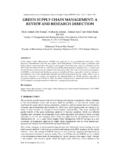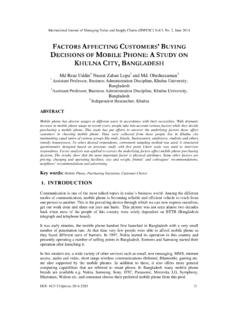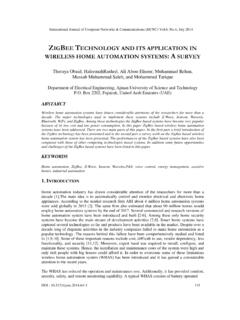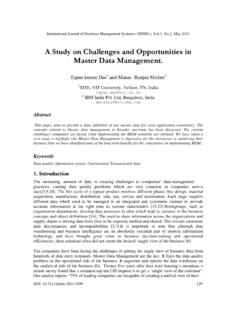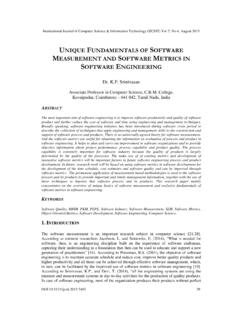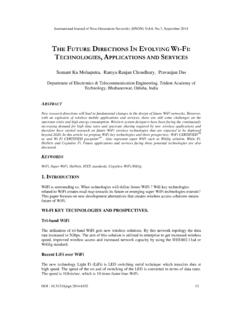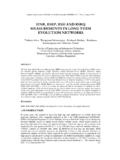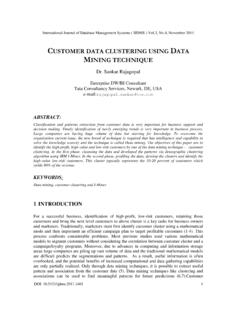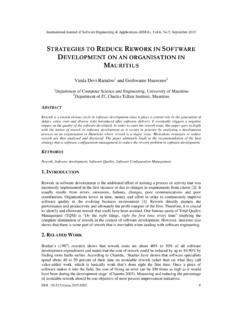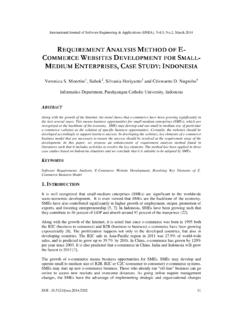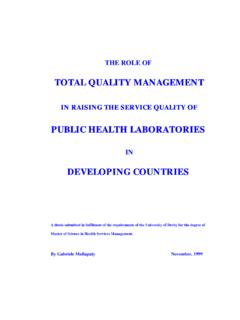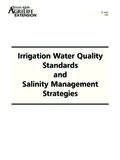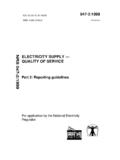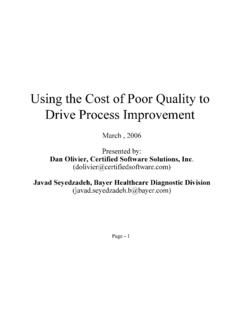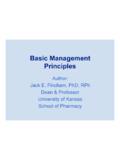Transcription of HIDDEN COSTS OF QUALITY: MEASUREMENT & …
1 International Journal of Managing Value and Supply Chains (IJMVSC) Vol. 6, No. 2, June 2015 DOI: 13 HIDDEN COSTS OF quality : MEASUREMENT & ANALYSIS Sailaja A1, P C Basak2 and K G Viswanadhan3 1 School of Management, Indira Gandhi National Open University (IGNOU), New Delhi, India, 2 Former Professor of Management , Indira Gandhi National Open University (IGNOU), 3 Principal, College of Engineering & Management, Punnapra, Kerala , India ABSTRACT quality is the assurance of adherence to the customer specifications and it is a measure of excellence or a state of being free from defects, deficiencies and significant variation from standards.
2 Customer specification of the product can be met by strictly adhering to the quality control measures in the production process and can be ensured in a cost effective manner only if the quality of each and every process in the organization is well defined and ensured without any lapses. Every activity in the supply chain line to be critically verified to identify the quality deviations incurring additional expense or loss to the organization. This is in line with the continual improvement principle of TQM philosophy . The cost of quality management system acts as the most significant tool in measuring, monitoring, controlling and decision making activities in a firm which aims on business excellence.
3 KEY WORDS quality cost , HIDDEN COSTS , Opportunity COSTS , Pareto Diagram, quality Management System. 1. INTRODUCTION A strong control over the management of utilization of resources of all categories in a manufacturing process becomes the demand of the day due to the high competition among the players of the present market. The resources-man, material, machine and time-to be utilized in a most cost effective manner to ensure the profitability of any business and at the same time no compromise in the quality is permissible. This is the highly competitive globalized market scenario today. Hence management and financial accounting have an important role in the MEASUREMENT and control of the components of manufacturing COSTS .
4 On the other hand quality improvement programs for attaining continual improvements have become essential to any business organization to thrive forward profitably with enhancement in its customer base. The question is how to achieve both these objective without losing organizational interests. cost of quality has evolved as the answer to this question. cost of quality analysis is considered as one of the most effective management tool for gathering and analyzing the expenses in maintaining quality in a manufacturing process and also identifies the non-value added expenses. quality improvement International Journal of Managing Value and Supply Chains (IJMVSC) Vol.
5 6, No. 2, June 2015 14 programs can be critically analyzed using quality costing techniques to check the merit of the program. This helps the management to identify the areas for improvement in quality as well in reducing wastages and hence ensure profitability. cost of quality or quality COSTS in a broader sense is the expenses incurred by an organization in achieving and maintaining good quality as well as in managing poor quality throughout its line of operations with an aim to attain highest level of customer satisfaction. The cost of quality analysis triggers changes and provide proof why changes should be made. The need to improve the financial position of an organization directly correlates with the process of making quality improvements.
6 cost of poor quality will tend to zero, if every activities are performed well in time. Many models of quality cost analysis have been evolved since the inception of this concept by the quality guru Dr. Joseph Juran in 1950. The classical PAF model by Feigenbaum (1956) which distinguishes quality COSTS into Prevention-Appraisal-Failure categories, Process cost Model by Marsh and Ross (1976) classifying quality COSTS into cost of conformance and non-conformance in the manufacturing processes, Opportunity cost Model by Sandoval- Chavez (1998) with the addition of opportunity losses to the other traditional models and the ABC-COQ integrated model by Tsai (1998) are the prominent models among them.
7 Many more dimensions have been added to the quality cost analysis by researchers like Steve Elridge (2006) who has added knowledge management concept to quality , Sower etal (2007) who has analyzed the quality cost as a measure of system maturity with the analysis of the relationship between quality and quality COSTS and Ali Uyar (2008) and Zulnadi yakup (2010) who have analyzed quality cost as money invested and money lost. The difficulties in implementation of a COQ system (Ming Tsung-2010), insufficiency in reports (Lee Hoon Tye-2011), in capability of addressing intangible COSTS (Assissi Jaffer-2010) and non synergy with TQM concepts (Aviora Aspinwal-2009) were addressed by many researchers.
8 Technological advancements in management were also effectively utilized by many researchers in analyzing quality cost . Behdad Kiani etal (2009) designed a model for analyzing the influence of COSTS of quality through a system dynamics approach. Mahanty. B (2012) developed a system dynamics model of quality cost in a manufacturing firm with the new features like time dependent deterioration process, formation of quality perception and market reaction. Arman Sadreddin etal (2014) developed a cost of quality (COQ) model for the procurement process of the construction industry to establish a general course of action for minimizing quality COSTS which take into account not only the internal quality COSTS within the company, but also the COSTS of its suppliers.
9 Several different policies were designed and their effects on quality COSTS investigated through System Dynamics (SD) simulation. Mathematical modeling was effectively used by NVR Naidu (2008) for analyzing quality cost categories. R K Sharma et al (2007) successfully applied a fuzzy approach to elicit expert opinion regarding the importance of cost items. The information so obtained after fuzzy synthesis is used to set up priority with respect to the processes which can provide necessary help to managers/ practitioners to invest efforts in reduction of cost of non-conformances (CONC) and optimal allocation of resources. Liang-Hsuan Chen, Ming-Chu Weng, (2002) proposed a fuzzy approaches to evaluate quality improvement alternatives because of its fuzzy nature.
10 An evidence fusion technique, namely Choquet fuzzy integral, is employed to aggregate the quality cost International Journal of Managing Value and Supply Chains (IJMVSC) Vol. 6, No. 2, June 2015 15 information. quality cost improvement model for analyzing conflicting goals using fuzzy sets was presented by Wang, Ming-Chu et al (2010). Lin Zhang et al (2010) developed an extended quality Function Deployment (QFD) approach to assess quality cost of packaging machinery from technical perspectives. Evaluation criteria for quality assurance cost , quality loss cost and comprehensive technical requirements are introduced for analyzing technical requirements that transform from customer needs and AHP is used to calculate and normalize different quality requirement weights.
